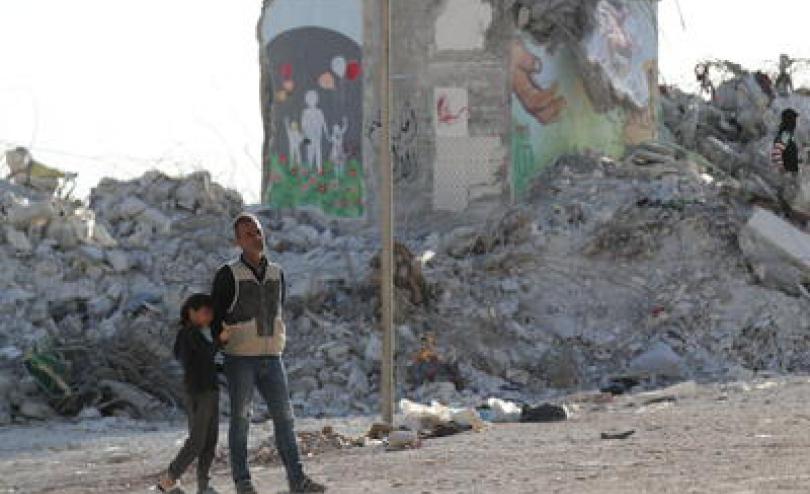WORLD'S 10 LARGEST CRISES FORCE OVER 10 MILLION CHILDREN FROM THEIR HOMES IN ONE YEAR - Save the Children

Photo: Khalil Ashawi/Save the Children
LONDON/GENEVA, 19 February 2024 – More than 10 million children were forced to flee their homes last year in the world’s 10 largest crises, according to new Save the Children analysis. This has likely pushed the number of children displaced globally to more than 50 million, the highest ever [1], with numbers more than doubling since 2010.
Save the Children analysed available figures from the 10 largest displacement crises of 2023 to see how many children were newly displaced across the year. [2]
The new analysis shows that during the year an additional 10.5 million children – or an average of about 29,000 a day [3] - were estimated to be newly displaced inside their own country or had fled to another country, with children in Sudan and Somalia the most affected.
While verified 2023 statistics will not available until later in 2024, Save the Children analysed the most recent displacement data from organisations including the UN’s International Organization for Migration and the UN Refugee Agency, UNHCR for the 10 crises to show the initial figures of child displacement. The number of people displaced globally has risen to a new record, according to the United Nations whose latest estimate shows that 114 million people were displaced as of October 2023.
Children make up around 40% of the world’s displaced people according to the UN [4], with millions forced to flee their homes every year. This leaves many unable to go to school, without enough to eat, with little access to healthcare, and at risk of abuse and violence as well as in need of psychosocial support after the events they have witnessed. Financial difficulties can force children into dangerous activities, including crime, child labour, sexual exploitation, or joining armed groups.
The number of children displaced has risen significantly in recent years and at a faster rate than the number of adults displaced, more than doubling from about 20.6 million in 2010. [5] But Save the Children said children remain largely invisible in displacement data which makes it hard to understand their needs, aspirations, and potential and to identify appropriate policy and programme responses.
Gabriella Waaijman, Save the Children’s Global Humanitarian Director said:
“Around the world, one in 73 people are living away from their homes because of forcible displacement, whether it be from conflict or from climate-related disasters, a ratio which has almost doubled in the past 10 years. Multiple displacement, where the same child is forced to leave their home again and again, is sadly the norm for many children in places such as Gaza, Syria and the DRC.
“While the statistics are overwhelming, a displaced child is not just a number. It's a child who has most likely witnessed the kind of violence or destruction no child should ever have to see, before having to leave behind everything that they know. When children lose their homes, they lose almost everything: their access to healthcare, education, food, and safety.
“Displacement affects children uniquely from adults and they make up a growing proportion of those forced to flee. We need to act urgently and keep the rights of children – who are the least responsible for the conflicts and climate emergencies that uproot them - at the centre of our responses to displacement.”
Sudan, after major fighting broke out last April, saw the biggest movement of children in 2023 with around 4.1 million children forced to flee their homes. Most of these - 3.3 million - have been displaced within Sudan while a further 850,000 children have fled to nearby countries including South Sudan, Chad and the Central African Republic and Egypt.[6]
Somalia saw the second-largest number of children on the move in 2023, mostly due to floods, drought, conflict and insecurity. Up to 1.6 million additional children may have been displaced internally or externally in 2023, bringing the total number of children displaced in Somalia to 2.4 million. [7]
The occupied Palestinian territory meanwhile was also among the top five locations where the situation deteriorated the most in 2023. Save the Children’s analysis found that around 890,000 children had left their homes in Gaza as of 21 December 2023 following the launch of Israeli military operations in response to attacks on Israel on 7 October. As of the end of 2023, the proportion of the population displaced within Gaza in just 10 weeks was one of the highest recorded globally [8].
Shady*, 40, a farmer from northern Gaza, fled to Al-Mawasi in southern Gaza with his family when the bombing intensified. They now live in a tent. A week after leaving, he finally managed to secure some essentials for his children such as blankets and clothing, but the cold weather, lack of nutritious food and poor sanitation are challenging.
“We left everything behind. All our possessions, everything we own, our clothes and bedding, everything remained behind," said Shadi.
“During the day, it’s hot inside the tent. And when night comes, it’s cold. It’s freezing cold until 7am. We snuggle in our clothes and snuggle our children in our clothes to get warm.”
Save the Children supports displaced children around the world to give them the vital supplies they need to survive and the things you can’t put in a bag - security, education, shelter, health, a place to play, laugh and learn, and someone to fight for your rights. The child rights organisation is working to support refugees and people displaced within their own countries and provide protection and support services at borders to help people settle as they arrive at new places. We also work inside some of the world’s largest refugee camps to provide learning opportunities, play centres and emotional support services.
Notes to editors
[1] Based on our analysis in combination with the latest UNICEF estimate of 43.3 m children living in forced displacement as of the end of 2022.
[2] These included Sudan, Somalia, the Democratic Republic of Congo (DRC), the occupied Palestinian territory, Turkey/ Syria (earthquake), Afghanistan, Myanmar, Ukraine, Ethiopia and South Sudan.
[3] Refugee numbers based on UNHCR’s refugee flow dataset (as of June 2023) and updated through Situation Reports when newer information on flows was available. IDP numbers based on IOM’s Displacement Tracking Matrix data and UN Situation Reports. Where a child breakdown was available this was used however, where it was not, national child shares were applied. A number of assumptions had to be made due to incomplete 2023 data.
[4] UNHCR
[5] According to UNICEF, during the same 2010 – 2022 period the total number of non-refugee child migrants rose by only 10%.
[6] Based on IOM’s DTM Sudan Weekly Displacement Snapshot 16 with data as of 4 January 2024. Child shares are based on applying IOM’s estimate that 54% of IDPs are children across the group.
[7] Refugee numbers based on UNHCR’s flow data for 2023 as of June. IDP numbers based on UNCHR’s Protection & Return Monitoring Network dashboard as of 31 December 2023. Since this counts displacements (meaning the same person might be counted twice), the number we provide is a rough estimate however UNHCR did report that at least 1m Somalis had been displaced between January and May.
*Name changed for anonymity.
For further enquiries please contact:
Aisha Majid, Data Media Manager in Madrid aisha.majid@savethechildren.org
We have Gabriella Waaijman, Save the Children’s Global Humanitarian Director, based in London available as a spokesperson.
Our media out of hours (BST) contact is media@savethechildren.org.uk / +44(0)7831 650409
Please also check our Twitter account @Save_GlobalNews for news alerts, quotes, statements and location Vlogs.




